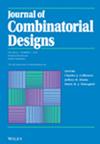Symmetric 2- ( 35 , 17 , 8 ) Designs With an Automorphism of Order 2
IF 0.8
4区 数学
Q3 MATHEMATICS
引用次数: 0
Abstract
The largest prime that can be the order of an automorphism of a 2- design is , and all 2- designs with an automorphism of order 17 were classified by Tonchev. The symmetric 2- designs with automorphisms of an odd prime order were classified in Bouyukliev, Fack and Winne and Crnković and Rukavina. In this paper we give the classification of all symmetric 2- designs that admit an automorphism of order . It is shown that there are exactly nonisomorphic such designs. Furthermore, it is shown that the number of nonisomorphic 3- designs which have at least one derived 2- design with an automorphism of order 2, is .
具有2阶自同构的对称2-(35,17,8)设计
最大素数p可以是2-(35)的自同构的阶,17 ,8)设计p = 17;所有的2- (35,17)具有17阶自同构的设计被Tonchev分类。对称的2- (35,17,具有奇素数阶p <自同构的设计;17个分类在Bouyukliev, Fack和Winne, crnkovovic和Rukavina。本文给出了所有对称2- (35,17,8)承认p = 2阶自同构的设计。结果表明,有11,642,495个这样的非同构设计。 进一步证明了非同构3- (36,18,8)具有至少一种派生2-(35)的设计, 17, 8) 2阶自同构的设计;等于1 015 225。
本文章由计算机程序翻译,如有差异,请以英文原文为准。
求助全文
约1分钟内获得全文
求助全文
来源期刊
CiteScore
1.60
自引率
14.30%
发文量
55
审稿时长
>12 weeks
期刊介绍:
The Journal of Combinatorial Designs is an international journal devoted to the timely publication of the most influential papers in the area of combinatorial design theory. All topics in design theory, and in which design theory has important applications, are covered, including:
block designs, t-designs, pairwise balanced designs and group divisible designs
Latin squares, quasigroups, and related algebras
computational methods in design theory
construction methods
applications in computer science, experimental design theory, and coding theory
graph decompositions, factorizations, and design-theoretic techniques in graph theory and extremal combinatorics
finite geometry and its relation with design theory.
algebraic aspects of design theory.
Researchers and scientists can depend on the Journal of Combinatorial Designs for the most recent developments in this rapidly growing field, and to provide a forum for both theoretical research and applications. All papers appearing in the Journal of Combinatorial Designs are carefully peer refereed.

 求助内容:
求助内容: 应助结果提醒方式:
应助结果提醒方式:


